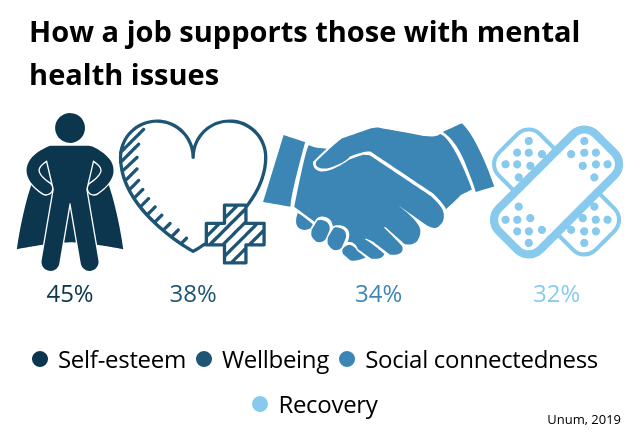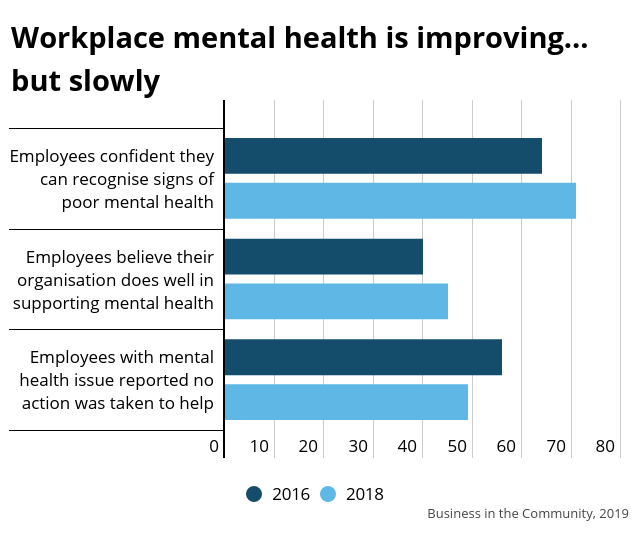“The idea of promoting good mental health applies to everyone in the workplace, not just the people who are struggling.”
So says mental health campaigner and activist, Rob Stephenson, and it is a point of view which cuts right to the heart of the issue of workplace mental health. “When it comes to workplace wellbeing, budgets usually go towards helping those who are suffering- which is morally the right thing to do - but I think it is just as important to focus on a move towards the thriving end of the mental health continuum.”
Indeed, mental health schemes which prioritise prevention can see a much higher return on investment (ROI) than those which only step in once a serious issue has been flagged. Service provider Anglian Water has gone so far as to enshrine employee mental wellbeing as a strategic objective, and have recorded an ROI of eight to one, in terms of reduced staff absence and increased productivity.
But what is a mentally-healthy workplace in practice, and how can business leaders go about creating one?
Can we champion role models who are embracing a good work-life balance? Can we start celebrating the person who leaves their desk at 5:30, rather than the one pulling the all-nighter?
Creating a mentally-healthy workplace culture
Ultimately, promoting good mental health at work is a question of company culture. Although yoga sessions, massage vouchers, and free fruit are all excellent work perks with definite benefits, creating a mentally-healthy workplace begins with making sure all employees enjoy a good work-life balance.
“I think people feel stressed because there is more pressure than ever before to be ‘always on’,” says Rich Pierson, CEO and co-founder of mindfulness app, Headspace. “Technology isn’t inherently bad, it’s our relationship with it that can make us feel anxious or overwhelmed at times.”
Step one for creating a mentally-healthy workplace, therefore, is to set firm boundaries around technology and availability. No answering emails at 10pm, no messaging people outside of the working day, no conference calls from the beach while on holiday. There must also be rules around taking breaks throughout the day and respecting regular work hours wherever possible.
Step two lies in encouraging employees to socialise at work and support their colleagues, especially if they notice someone taking on too much and suffering because of it. “We’re in a unique position in the workplace,” says Mr Stephenson, “we see people for eight hours a day, every day. If we take the time to notice our colleagues and learn their behaviors, then we can notice when those behaviours change. We can intervene when people are acting differently from their norm. It’s about showing a genuine interest in people.”
Business leaders becoming mental health role models
It sounds simple - because it is. But big cultural change takes time, and it is change which needs to come from the top.
“You need to lead from the front,” says Angela Armstrong, founder of leadership development firm, Armstrong, “because people do what they see, not what you say.” If the CEO leaves late every evening and rarely takes their holidays, encouraging staff to do the opposite will be an uphill battle. Those in positions of authority need to embody the change they wish to see, tacitly giving their staff permission to live more balanced lives.
A crucial part of creating a mentally-healthy workplace lies in destigmatising the conversations around mental health issues in the first place, so that those employees who might be struggling can feel comfortable seeking help. This too must be pioneered by those at the top.
“We need to stop being afraid to have the conversations around mental illness and we need more role models at the senior level to lead the way,” says Mr Stephenson, whose organisation InsideOut has a leaderboard of executives who have chosen to ‘come out’ about their own struggles. “Can we champion role models who are embracing a good work-life balance? Can we start celebrating the person who leaves their desk at 5:30, rather than the one pulling the all-nighter?”
Technology isn’t inherently bad, it’s our relationship with it that can make us feel anxious or overwhelmed at times
How organisations are promoting good mental health
The other undeniable positive of having a “bought-in” CEO when it comes to mental health in the workplace is that they will have a headstart on seeing the value of wellbeing schemes. Creating a mentally-healthy workplace may not always demand specific initiatives, but making an active commitment to such projects can help send a message to staff that their mental wellness is important. So, what do workplace mental health schemes look like in practice?
Headspace: Mindful Breaks
As a mindfulness app well-known for its range of guided meditations, Headspace could be seen to have an advantage over other companies when it comes to promoting good mental health. But every business will have to deal with heavy workloads and full agendas at some point, so Headspace have taken the initiative and scheduled in time for employees to pause. “We have two Mindful Breaks scheduled on everyone’s calendars each day at 10am and 3pm,” says Mr Pierson, “it’s a reminder for everyone to take a break, participate in our group meditation, take a walk, read a book or take some time for themselves. There can still be this negative association with taking time for yourself, since it could be perceived as a form of slacking off at work. But the tide is slowly turning as more and more companies recognise the value of investing in their people’s well-being.”
Cicero: Take II
Financial PR company, the Cicero Group, has introduced a programme known as “Take II”, a flexible working scheme which allows every employee to take two free hours of leave per week. These hours are set aside so that each person can prioritise their mental health, prompting them to visit a gallery, go to the gym or even enjoy a lie-in.
Add People: Culture Club
Digital marketing agency, Add People, has baked openness and collaboration into its culture with its monthly ‘Culture Club’. “Every team sends a delegate to check that people are happy and the culture is where it needs to be,” says Caitlin Rimmer, a mid-level content and SEO specialist at Add People, who suffers from PTSD and depression. “We’re currently focussing a lot on how to support women and queer people especially, which is really important to me. There’s a real willingness to listen to employees and to value the emotional labour that goes into work”. And it is clearly working, as Laughology (a training and consulting organisation built around the psychology of happiness) nominated them as one of Manchester’s happiest places to work in 2017.
Three: Your cause, your way
Telecommunications giant, Three, promotes good mental health both through Wellness Wednesdays, a scheme which encourages staff to take two hours to prioritise their wellbeing, but also by acknowledging people’s interests outside of the workplace. Their ‘your cause, your way’ programme offers staff an extra day’s leave to volunteer, nominate a charity for a donation or access match funding for their own fundraising efforts, helping them to support the causes they love.
Fundamentally, the recipe for creating a mentally-healthy workplace is simple: a good work-life balance, supportive colleagues, inspiring leaders and the time and space to look after oneself. “These concepts are age-old, simple, and free,” says Ms Armstrong, whose recent book The Resilience Club, explores the habits of long-term high performers. “Common sense isn’t always common practice, so it has to be formed into habit, but the concepts are simple. Get those right and you won’t need some shiny, bells-and-whistles scheme. It’s really just about letting people look after themselves better.”
Related articles:
How to support employees with mental health problems
Creating a mentally-healthy workplace culture


